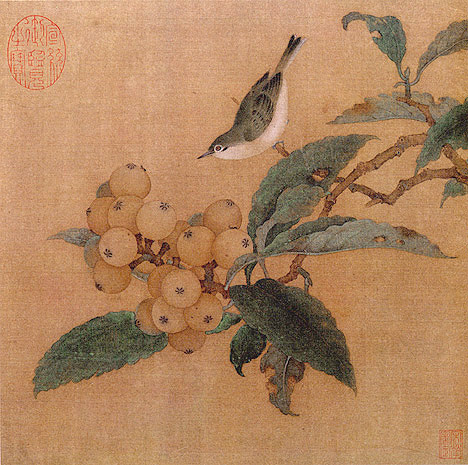
Loquats and a Mountain Bird
Loquats and a Mountain Bird, by an anonymous painter of the Southern Song Dynasty (1127–1279); small album leaf paintings like this were popular amongst the gentry and scholar-officials of the Southern Song.

Bamboo
Wen T'ung (1019-1079). Ink Bamboo. Ink on silk. Bamboo is among the most common and beloved subgenres of Chinese painting. There are several reasons. First, the bamboo plant itself, which grows prolifically in China, is symbolic in Chinese culture for moral integrity, purity, and the ability to withstand adversity, all features that can be observed in the actual plant itself. Second, painting bamboo with the Chinese ink brush is closely akin to Chinese calligraphy, and many of the same techniques and brush strokes are used in both genres. Bamboo painting is thus became the most natural form of artistic expression for Chinese literati, all of whom were first required to master calligraphy. Chinese connoisseurs held that the brush work in such a painting, as in calligraphy, revealed the inner personality of the artist. Nevertheless, bamboo painting evolved quite late in Chinese history; Wen T'ung is one of its early masters, and his style was much copied in later times. Particularly attractive in this work is the use of contrasting ink shades to render depth; in other words, leaves closer to theview are darker, leaves farther away are lighter.

Elegant Gathering in the Apricot Garden
On April 6, 1437, Yang Rong, a high-ranking scholar-official serving the emperor of China, invited eight important officials and dignitaries to his famous garden to view paintings and calligraphy, compose poetry, and play chess. One of these invited officials is seen above, brush in hand, poised to write a poem on the paper unrolled on the table before him. Two other guests admire a painting in the format of a hanging scroll. The servant on the left is readying another hanging scroll for viewing while two more hanging scrolls lie rolled up on the low table beside him. Yang Rong served at the court of five successive emperors, rising to the rank of grand secretary, the highest official position in the Ming dynasty court.
In this feature you will have an opportunity to look closely at and learn more about a number of Chinese paintings and calligraphies (brush writings). Just think of yourself as a guest at this party, composing a poem or taking an imaginary journey through a distant landscape by examining a painting, as these gentlemen are doing.

